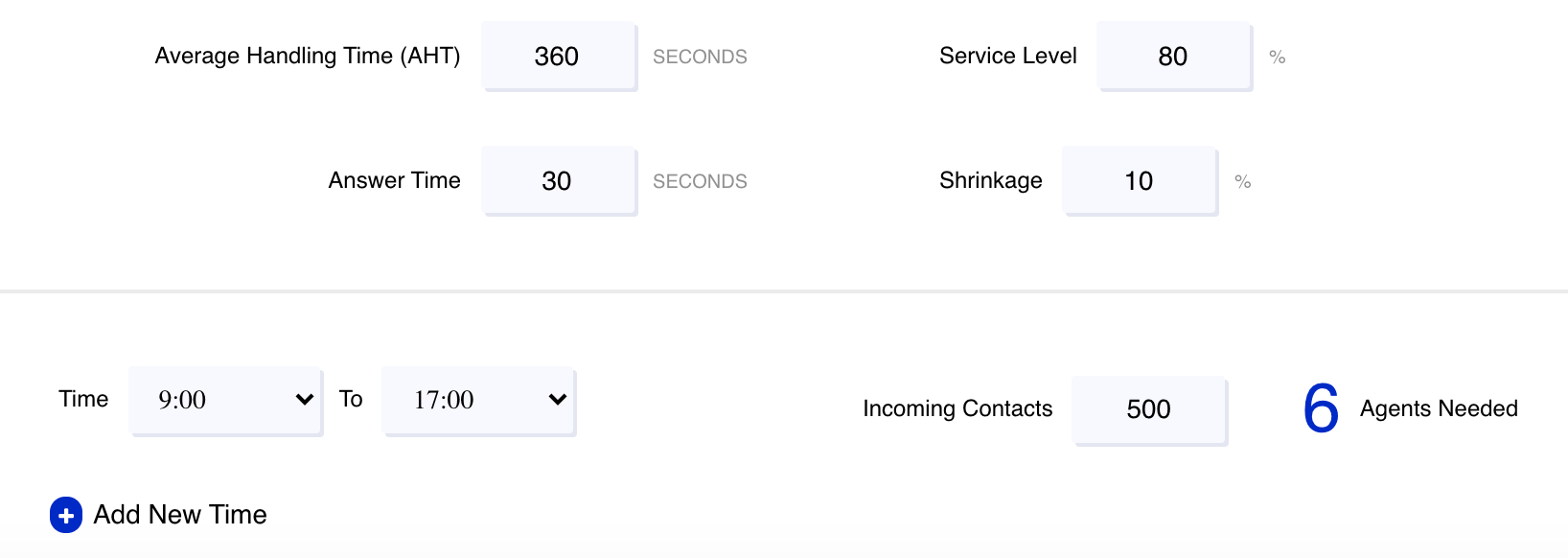Call Center Workforce Management 101

How do you make sure you have the right number of agents on call? Your call center’s success depends on it. Yet, it’s not easy to find the optimal number of agents you need. Follow these call center workforce management best practices to find out how to staff your contact center the right way.
What Is Call Center Workforce Management?
Workforce management is the institutional process of maximizing the efficiency and performance of an organization. In a call center, workforce management comes down to how you staff your agents. The goal is to ensure that you have the right number of agents with the right skillset at the right time.
Every call center’s workforce management comes down to four basic principles: forecasting, scheduling, assigning agents, and managing on the day. Let’s take a look at how these components of call center workforce management interact.
Forecasting
Forecasting is one of the most important parts of running a call center. It’s the process of calculating how many calls your call center should expect in a given period of time. No, you don’t need a fortune teller to help you here. You only need to examine the data you already have.
Identifying the trends and patterns in all your data can help you determine what you should expect. The accuracy depends on how well you keep track of your data. But, you also need a bit of intuition at times.
You always need to think of unforeseen or emerging trends. More calls around Black Friday? Fewer calls when the summer holiday starts? Every call center is different, so make sure you know the trends. Look at the data weekly, monthly, and yearly to stay informed.
Scheduling
Once you know how many calls you should expect, you can start to schedule the shifts you need to cover these. You’re not thinking about rotas and specific agents yet. Just the labor needed to cover the times you need to cover.
Accurately scheduling shifts to match the call patterns will improve your service, customer satisfaction, and workplace environment.
Pro tip: Use Expivia’s staffing calculator to make this step easier.
Assigning Agents
Once you know what shifts you have, you need to fill these. This is where individual employees and their skill sets are important. You’ll want to schedule the right agents for the right time.
But, it’s also crucial not to overwork your agents. Stressed employees are the downfall of any call center.
Intraday Management
Finally, you have agents on your floor, taking the calls in the patterns you predicted. Sadly, this isn’t the time to relax yet. You need to manage the day-to-day tasks of running a call center. While the previous steps were all in anticipation, intraday call center management is about reaction.
Nobody can predict technical faults, product recalls, or national emergencies. You’ll need to create a guideline and a contingency plan if anything unexpected happens.
Intraday management isn’t all doom and gloom. It can also be quite fun. Playing call center games for example is a great way to motivate your employees on the day. To see how to make that happen, check out these 23 call center games you can try.
How to Calculate Staffing Your Call Center
Knowing the main principles of call center workforce management alone won’t help you do it yourself. This guide can help you break your current operations management down, so you know how to optimize it.
Track Your Call Center’s Performance
Before you come up with numbers, you need to look at what you have first. Keeping good track of your data is the most important call center workforce management best practice. But, there’s a lot of data you can collect.
Here are the categories of numbers you actually need to pay attention to when you’re staffing your call center:
Calls Per Interval
How many calls do you get per hour? Per day? Per week? If your center opens to callers at 8 AM and closes at 9 PM, count every call during those hours. Mark these numbers down daily. You’ll want to compare multiple dates of data to see the whole picture.
Average Handle Time
The handle time starts when the call hits the queue and ends when the agent wraps-up the memo. Everything in between counts.
Knowing your call center’s average handle time is crucial to running an effective contact center. Plus, you can evaluate individual performance, optimize scheduling, and improve customer satisfaction.
Answer Time and Service Level
The industry average for service level and answer time is 80/30. This means 80% of the calls get an answer in 30 seconds or less. Some call centers are more strict about this, others are more relaxed. It’s up to the culture of your organization to know how quickly your agents need to answer calls.
Shrinkage
No matter how professional and dedicated your employees are, everybody misses some work. Arriving late, taking sick days off, or even taking a coffee break takes time away from your phones. While this isn’t a bad thing, you still need to calculate with this too.
Shrinkage is usually a percentage amount. Your company’s culture can define what your acceptable shrinkage is. A more relaxed environment is better for your employees, but worse for your overall numbers. Finding that balance of ease and effectiveness is a crucial part of call center workforce management.
Use the Expivia Staffing Calculator
You have a bunch of data and numbers. Now what? The easiest way to figure out how many agents you need at any given time is to use the Expivia staffing calculator.
You need to put all the numbers you kept track of into the calculator, and it will automatically generate the number of staff you need on call. You can even divide it by the hour, so you can instantly schedule your employees.

Why Is Call Center Workforce Management Important?
Although call center workforce management isn’t the easiest part of running a call center, it’s a necessary one. There are a lot of benefits to optimizing your operations. These are the most important reasons and positive outcomes you can expect if you do it right.
- Improved customer satisfaction: Every call center’s main goal is customer satisfaction. If you don’t have enough agents on the floor, you’ll have to put customers on hold. Nobody likes that. But if you have a well-trained staff that gets the calls on time, you’re already ahead of the game.
- Happy Employees: Your agents want to contribute to the success of your call center. By optimizing your workforce, you’re making their lives easier. They’ll have a healthier work culture, avoid burnout, and feel pride in their work.
- Call Center Operational Efficiency: Call center workforce management helps your office run better. It turns the hectic contact center environment into a well-oiled machine.
- Saving Time and Money: Ultimately, workforce management is about time management. And time is money, especially in a call center. By making your operations as efficient as possible, you can save a lot of money in the long run.
A Call Center With Optimized Workforce Management
There are plenty of workforce management tools out there. But, are these going to take your company culture and employees into account? Or will they squeeze the soul out of your business to improve numbers?
Only professionals know how to run a call center effectively and humanely. So, why not trust an experienced call center to do it for you? At Expivia USA, we already use the best practices in workforce management. And we found a balance between great customer service and employee engagement.
Our success rate is the proof! For more information on how to improve your call center metrics and get your employees to enjoy the work they do, reach out to us!





Pingback: Call Center Management Training: How to Make Leaders | Expivia
Pingback: 15 Crucial Call Center Metrics and KPIs You Need to Know | Expivia
Pingback: What Is an Omnichannel Contact Center? | Expivia